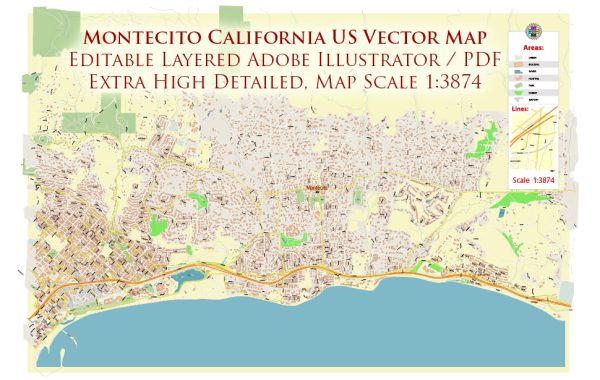Montecito, located in Santa Barbara County, California, is a picturesque and affluent community known for its upscale estates, beautiful landscapes, and proximity to the Pacific Ocean. The history of Montecito’s urban development reflects a blend of natural beauty, architectural elegance, and the influence of prominent individuals.
- Early History: Before European settlement, the area that is now Montecito was inhabited by the Chumash Native American people. Spanish explorers arrived in the 18th century, bringing with them missions and ranchos. The Mission Santa Barbara, established in 1786, played a significant role in the region’s development.
- Ranching Era: In the 19th century, much of the land in Montecito was used for ranching. The Mexican land grant Rancho San Marcos was awarded to José Francisco Ortega in 1804. Later, the land passed through various hands as ranchos were divided and sold.
- Early 20th Century: The development of Montecito as a residential community began in earnest in the early 20th century. The construction of the Southern Pacific Railroad made the area more accessible, attracting wealthy individuals looking for an idyllic retreat.
- Prominent Figures: Montecito became a favored destination for wealthy industrialists, celebrities, and business magnates, including the likes of Charlie Chaplin, Ellen DeGeneres, Oprah Winfrey, and many others. The presence of such influential figures has contributed to the area’s exclusivity and luxurious reputation.
- Architectural Styles: The architectural landscape of Montecito is diverse, featuring a mix of Mediterranean, Spanish Colonial Revival, and other styles. The renowned architect George Washington Smith had a significant impact on the region, influencing the design of many estates during the 1920s and 1930s.
- Natural Disasters: Montecito has faced challenges from natural disasters, including wildfires and mudslides. The community’s resilience in rebuilding and implementing measures to mitigate such risks showcases its commitment to maintaining its unique character while addressing environmental concerns.
- Modern Development and Conservation: Today, Montecito continues to be a sought-after residential area, with a blend of historic estates and newer, carefully planned developments. The community has also demonstrated a commitment to conservation, preserving open spaces and maintaining a balance between development and environmental stewardship.
- Cultural and Recreational Attractions: Montecito is home to cultural and recreational amenities, including art galleries, upscale shopping, and beautiful parks. The Lotusland botanical garden and the Music Academy of the West are among the notable institutions in the area.
In summary, Montecito’s history of urban development reflects a journey from its roots in ranching and Spanish colonial influences to its present status as an exclusive and carefully planned residential community, renowned for its natural beauty, architectural splendor, and the presence of influential residents.


 Author: Kirill Shrayber, Ph.D.
Author: Kirill Shrayber, Ph.D.